[Click on thumbnails for larger images. You may use these and the following images without prior permission for any scholarly or educational purpose as long as you (1) credit the photographer and (2) link your document to this URL in a web document or cite it in a print one.]

"[G]olden Arno as it shoots away / Straight through the heart of Florence" (Elizabeth Barrett Browning, Casa Guidi Windows I: 3, ll. 53-4). The word "golden" reminds us that the Ponte Vecchio or Old Bridge, seen here, was where the Florentine goldsmiths had their shops; there are still jewellery shops on the bridge.


Left: The communion table in front of which the Brownings were married. Right: the Cathedral in Pisa, just a stone's throw from the Brownings' windows during their six months there.
On 12 September 1846, Elizabeth Barrett slipped out from the family home in Wimpole Street, and exchanged vows with Robert Browning at St Marylebone Church in London, in the presence of her loyal and trusted maid, Elizabeth Wilson, and Robert's cousin James Siilverthorne. The altar before which they took their marriage vows was returned to St Marylebone Parish Church in 2012, in time for the bicentenary of Robert’s birth, from the "Poets' Church" of St Giles-in-the-Fields, London WC2. It is now reunited with the Benjamin West, PRA, painting of the Holy Family which hung above the altar at the time of the poets’ marriage. Elizabeth then went on to visit her old tutor and close friend, the Greek scholar Hugh Stewart Boyd, returning home some time after Wilson, as if nothing had happened. But a week later, on 19 September 1846, when the Barretts were due to leave town for their rented property in Little Bookham, Surrey, she slipped away again and the couple took their second momentous step and left for Italy. They were accompanied by Wilson and Elizabeth's beloved spaniel, Flush. After a choppy crossing to Le Havre and a jolting carriage ride to Paris via Rouen, they had a very brief honeymoon in the French capital before travelling on via Orléans and Avignon (to see Petrarch's Vaucluse) to Italy. The writer and art critic Anna Jameson and her niece Gerardine accompanied them on this leg of the journey. Since Jameson had warned them against Florence, describing it as "British to the teeth and bursting at the seams with balls and hoopla" (Markus 121), they first took a six-months' lease on lodgings in Pisa, seeing out the lease and remaining there until 17 April 1847. At first, after the strain of the journey and the harsh condemnation that Elizabeth had by now received from her father and brothers, a quiet life was just what they needed. But, despite their delight in each other's company, Pisa began to pall. They needed a larger circle of friends and field of action than it could afford them (see Forster, in her recreation of this period in their lives, 216-17). Florence could offer these, and more. With its beautiful architecture and river now bathed in sunshine, it turned out to be all they could have hoped for.
Casa Guidi


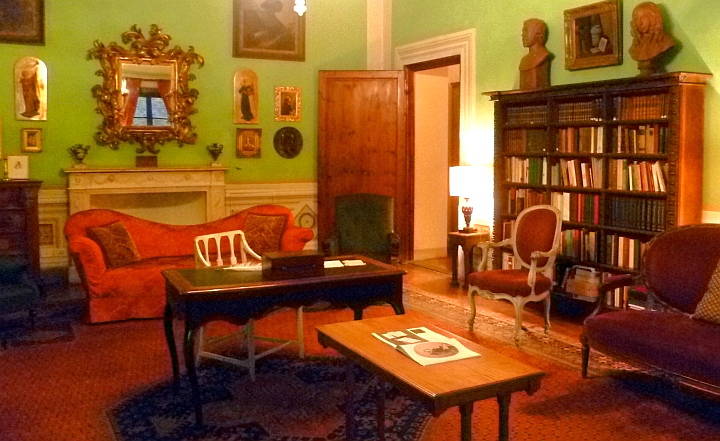

Left to right: (a) The Palazzo Guidi, the Brownings' home in Florence for fifteen years. (b) The large carriage door at the front, now with a plaque over it recording Elizabeth's residence. (c) Their Drawing Room, at the heart of their suite. On top of the bookcase stand terracotta busts of the two poets; Elizabeth's is shown in close-up below. (d) The bedroom, in which the Brownings' son was born in 1849, and in which Elizabeth died in 1861.
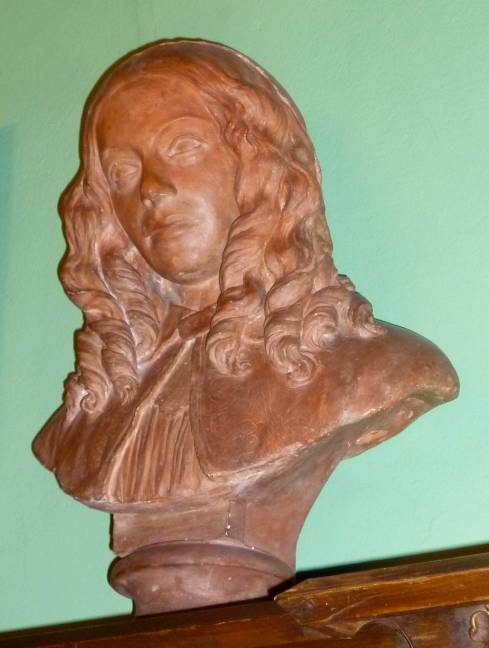
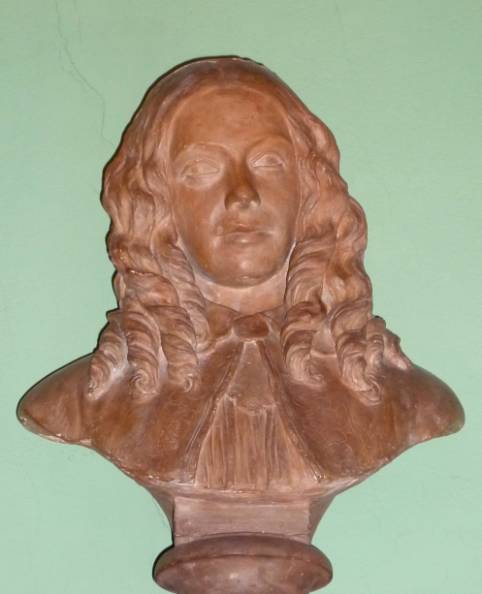


Left to right: (a and b) Two views of Elizabeth's bust, by the American sculptor William Wetmore Story, c.1864. (c) The Brownings' clasped hands, in bronze, also on display in Casa Guidi. This was the work of Harriet Hosmer in 1853. Story's friend Hosmer was the "first American woman stonecutter" (Markus 194). (d) A fairly recent copy of Thomas Woolner's 1856 medallion of Browning hanging on the wall here.
From Florence Elizabeth wrote excitedly to Anna Jameson in August 1847, "we are settled magnificently in this Palazzo Guidi on a first floor in an apartment which looks quite beyond our means, and would be except in the dead part of the season." From the undeniably "dreary entrance" (McMahan 15), stone stairs led up to "a suite of spacious rooms opening on a little terrace and furnished elegantly — rather to suit our predecessor the Russian prince than ourselves" (Letters I: 334). The Brownings were eventually able to take out a long-term lease on it, and soon rechristened it "Casa Guidi," a homelier, less pretentious name that suited their republican sympathies. They furnished the place themselves, redecorating the drawing room in the colours of the forbidden Italian Risorgimento flag — red, white and green (see Bolton and Holloway 508). The fireplace and mirror now in the room are original, and the paintings and furnishings are either copies of or similar to what would have been there during their residence. The drawing room was the heart of the suite.
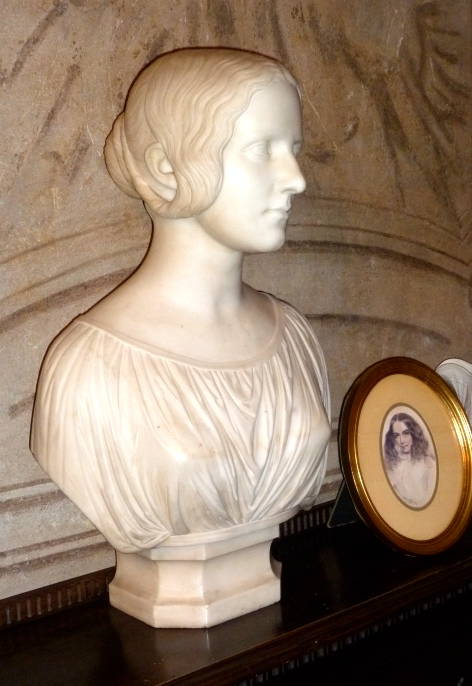
Marble bust of the poet Eliza Ogilvy, the Brownings' upstairs neighbour and close friend at Casa Guidi, next to a picture of Elizabeth. The bust was placed here later, by one of Eliza's descendants.
Elizabeth told another close friend, the writer Mary Russell Mitford, "You will hardly image to yourself the retired life we live, or how we have retreated from the kind advances of the English society here" (Letters I: 437). But this seems somewhat disingenuous. In the first place, the Brownings soon acquired as upstairs neighbours a large and lively Scottish family, the Ogilvys. Eliza Ogilvy, to whom Elizabeth had already been introduced, and whose volume of poetry, A Book of Highland Minstrelsy had been published in 1846, became a close friend. Already the mother of three young children, Eliza was a great support to Elizabeth at the time when her only son Robert Weidemann ("Pen") Browning was born in 1849. The families were close enough to take trips together, to Venice for instance, where Eliza accompanied Elizabeth on her walks. The Brownings received many other cultured fellow-expatriates in Casa Guidi, including artists like the American sculptors William Wetmore Story (1819-95), Harriet Hosmer (1830-1908) and Hiram Powers (1805-73), the elderly and eccentric Walter Savage Landor (1775-1864), and the novelist Isa Blagden (1818-1873). The latter was very active in the Anglo-Florentine circle, and, like Eliza Ogilvy, as devoted to the Italian Risorgimento as Elizabeth and Eliza were. Other important visitors included the Trollopes — that is to say, Fanny Trollope and her daughter-in-law Theodosia, for Fanny had been living in Florence since 1843 and was also at the hub of expatriate life there. Theodosia Trollope-Garrow was yet another poet who passionately supported the Tuscan uprising.
The Pitti Palace



Left to right: (a) The Pitti Palace from the rear, brightened even on a dull day by its local yellow sandstone. (b) Neptune's Fountain (statue by Soldo Lorenzi, 1571), one of many features in the Boboli Gardens.(c) A misty view of the city from a corner of the Boboli Gardens, showing the Duomo, the Basilica del Santa Maria del Fiore, with its campanile.
Elizabeth described Casa Guidi as being "cool and in a delightful situation, six paces from the Piazza Pitti, and with right of daily admission to the Boboli gardens" (Letters I: 334): not only was their new home close to the Arno and the magical Ponte Vecchio, but it almost faced the largest palace in Florence, with vast and beautiful formal gardens to which they had access. Once home to the tyrannical Medicis, the Pitti Palace is so enormous that its rooms and grounds now house eight museums.
Appropriately enough, the couple were witness to a huge celebratory parade to the palace on their first wedding anniversary, 12 September 1847. From the windows of neighbouring rooms, they watched people of all parts of Italy and beyond march to the Piazza Pitti opposite to thank Grand Duke Leopold II for restoring their civic liberties. Now indeed Elizabeth felt that Italy was "the darling of the earth" (Casa Guidi Windows Part I, 30, l.1165). She looked down from the windows and felt that their cause was just and that it would prevail. In this she was like so many other British writers at this stirring time, including, for example, Swinburne, George Meredith, and George Eliot — who "read, or re-read, Casa Guidi Windows while writing Romola" (Ashton 264). Landor had also been won to the cause (see Santini 23). But Elizabeth has been more specifically linked with the other expatriate women poets residing in Florence. Their involvement in the Italian struggle is felt to have mirrored "the woman poet's quest for liberation from British patriarchy" (Chapman 57). This seems particularly pertinent to Elizabeth herself, at this time when she was establishing her own life there after having escaped the heavy domination of her father.
The City of Florence and Its Influence on the Brownings' Work


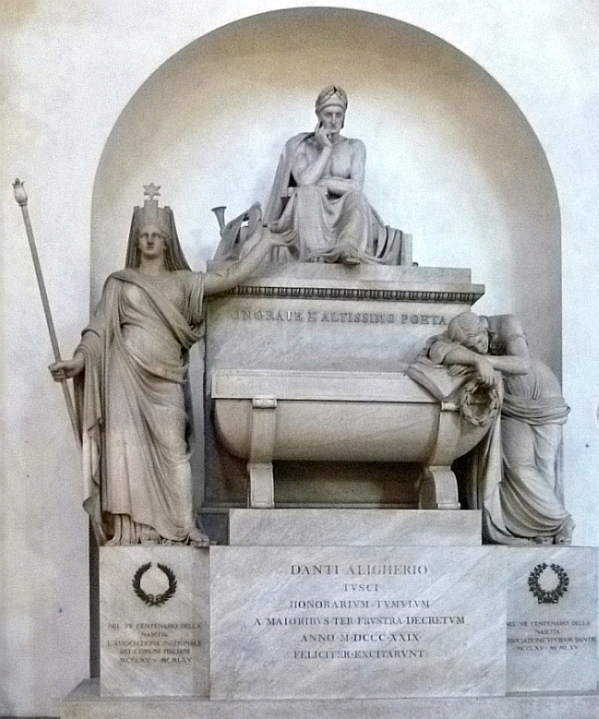
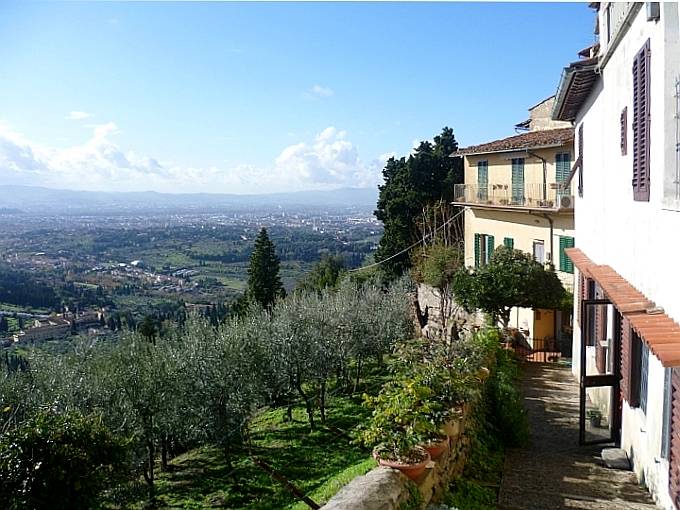
Left to right: (a) A fibreglass replica of Michelangelo's David, placed on the roof of the Duomo for one day only (12 Nov. 2010, for the inauguration of the Florence 2010 celebration). This is the site for which the statue was originally intended. (b) The Basilica of Santa Croce, with its 19c. neo-Gothic façade designed by the Jewish architect Niccolo Matas. Note the Star of David in the tympanum. (c) Cenotaph to Dante inside the church. (d) View from Fiesole in the hills above Florence. Elizabeth walked up and sat on an old wall to admire the view, perhaps from this very spot (see Markus 184).
As Anna McMahan said long ago, the fifteen years during which the Brownings were based in Florence were for both "a period not only of supreme happiness but of continual literary production, most of which was profoundly and essentially influenced by Italian conditions and Italian atmosphere" (13). From the start, the city filled Elizabeth with wonder: "I have stood by Michael Angelo's tomb in Santa Croce," she wrote to Boyd soon after arrival. Boyd had been blind for many years now and she strove to convey to him something of the quality of Florence's great religious buildings. "I have looked at the wonderful Duomo," she continued.
This cathedral! After all, the elaborate grace of the Pisan cathedral is one thing, and the massive grandeur of this of Florence is another and better thing; it struck me with a sense of the sublime in architecture. At Pisa we say, "How beautiful!" here we say nothing; it is enough if we can breathe. The mountainous marble masses overcome as we look up — we feel the weight of them on the soul. Tesselated marbles (the green treading its elaborate pattern into the dim yellow, which seems the general hue of the structure) climb against the sky, self-crowned with that prodigy of marble domes. It struck me as a wonder in architecture. (Letters I: 331).
Their new experiences in Florence, and indeed in Italy as a whole, were to be woven inextricably into both poets' oeuvres. McMahan talks of "the large part played by the local colour of the city, the multitude of allusions to the churches, the piazzas, the pictures, the statues and the traditions of Florence" (14) in their poetry. For example, the Duomo features in Elizabeth's Casa Guidi Windows as "Brunelleschi's church" (Part I, 15, l. 605); while its campanile, "the startling bell-tower Giotto raised," set off the whole chain of thought that inspired Browning's "Old Pictures in Florence" (stanza 2, l.15). The latter poem gives a better idea of what Florence really meant to the two poets, for it provided far more than just a setting for their work.
For Elizabeth, just looking out of the windows on that first wedding anniversary proved hugely inspirational. Her passionate support for Italian liberation and unification in that first long poem is filled with an intimate knowledge of the city and those associated with it, including of course Dante and Michelangelo. Perhaps it was particularly Dante with whom she empathised, apostrophising him as "O passionate / Poor Dante, who, a banish'd Florentine, / Didst sit austere at banquets of the great," and describing his monument in Santa Croce as "forlorn / Of any corpse," since he was buried in Ravenna ( Casa Guidi Windows Part I, 15, ll. 607-09, 623-24). But she addressed "divinest Angelo" and other great artists as well (Casa Guidi Windows Part I, 4, l. 98). Begun in 1847, Casa Guidi Windows was published in two parts in 1851, and appeared simultaneously in Florence in an Italian translation The second part expresses Elizabeth's disappointment at the arrival of Austrian troops in May 1849, to which again the Brownings were first-hand witnesses from the neighbouring apartment. But she still offers encouragement to "this great cause of southern men, who strive / In God's name for man's rights, and shall not fail!" (Casa Guidi Windows Part II, 30, ll. 1201-2).

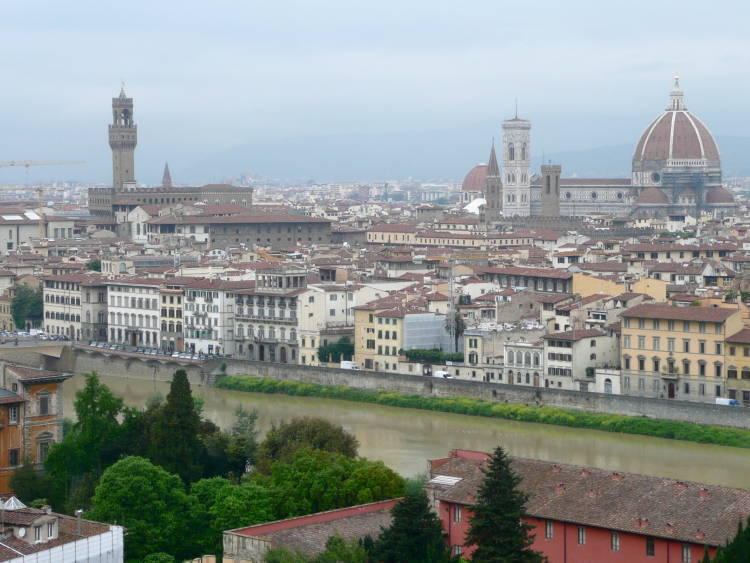

Left: A View of the Arno from the Pnte Vecchio. Middle: Florence seen from across the Arno, the Duomo on the right, and the Palazzo Vecchio on the left. Right: A Night view of the Arno. Thanks to Dr. William Lee, who took these photographs in 2010, for permitting us to use them.
But Florence did even more than provide the Brownings with subjects. This "most surprising riddance" of their old lives (Aurora Leigh 7: 1208), this freedom from the conventions and conditions of home, allowed their individuality to blossom, accounting at least partly for what was most fresh and original in their voices (see Armstrong 387-91). While Robert Browning found his imagination stirred by the eccentricities of others, such as the Florentine artists Andrea del Sarto and Fra Lippo Lippi, and other historical or literary figures, Elizabeth felt emboldened to carry her flouting of parental and societal expectations into the co-option of the traditionally male epic form. Her longest, most wide-ranging and philosophical work is the first-person novel-poem Aurora Leigh (1856). It is no accident that its eponymous heroine with her promising name is half-Florentine, spends her earliest childhood in the city, and returns to it later. Unlike her mother, who had danced "at the Pitti" (I: l.132) and was "weak and frail" (I: 33), Aurora rejects both dependence and stereotypes and (like Jane Eyre) marries her cousin Romney only after he has become blind. The vision at the end of the poem is of "new hearts in individual growth," and the new order that will spring from them: "new dynasties of the race of men" in which there will be new religious and economic institutions, and of course "new laws / Admitting freedom" (9: 943-48).
The plaque above Casa Guidi's door, placed there in 1861 by "Grateful Florence," pays tribute to Elizabeth Barrett Browning for making "with her verse a golden ring binding Italy to England" (trans. Markus 332). No doubt she is most honoured in her adopted city for Casa Guidi Windows, with its impassioned support of the Risorgimento. But perhaps Aurora Leigh gives a more profound insight into what Florence meant for her, and what she, in turn, wanted for Florence (and, more generally, for women and indeed the world).
Related Material
- The English Cemetery in Florence, and the Anglo-Florentine Community
- Ben Downing's Queen Bee of Tuscany: The Redoubtable Janet Ross (2013) [Review by A. Banerjee].
- Elizabeth Barrett Browning: A Chronology
- The Life of Elizabeth Barrett Browning
- Elizabeth Barrett Browning and Robert Browning
- American sculptors working in Italy
- The Fate of Art in "Old Pictures in Florence"
- Robert Browning's "Fra Lippo Lippi"
- Discussions of Robert Browning's "Andrea del Sarto"
- Aurora Leigh and Fictional Autobiography
References
Armstrong Browning library. Baylor University site. Web. 2 Feb. 2011.
Armstrong, Isobel. "The Brownings." The Victorians. Ed. Arthur Pollard. London: Penguin, 1993. 387-412.
Ashton, Rosemary. George Eliot: A Life. London: Hamish Hamilton, 1996.
Bolton, John Robert Glorney, and Julia Bolton Holloway, eds. Aurora Leigh and Other Poems. By Elizabeth Barrett Browning. London: Penguin, 1995.
Browning, Elizabeth Barrett. Aurora Leigh and Other Poems. Ed. John Robert Glorney Bolton and Julia Bolton Holloway. London: Penguin, 1995. (This is the text used here, but the e-text of Casa Guidi Windows can be found in Vol. IV of her poetry at Project Gutenberg, and that of Aurora Leigh in the Internet Archive.)
_____. The Letters of Elizabeth Barrett Browning. Ed. Frederic G. Kenyon. 2 vols. Vol. 1 London:Macmillan, 1897. Internet Archive. Web. 2 Feb. 2011.
Chapman, Alison. "The Expatriate Poetess: Nationhood, Poetics and Politics." Victorian Women Poets, ed. Alison Chapman. Cambridge: D. S. Brewer (for the English Association), 2003. 57-78.
McMahan, Anna Benneson, ed. Florence in the Poetry of the Brownings; being a Selection of the Poems of Robert and Elizabeth Barrett Browning which have to do with the History, the Scenery and the Art of Florence. Chicago: McClurg,1907. Internet Archive. Web. 2 February 2011.
Markus, Julia. Dared and Done: The Marriage of Elizabeth Barrett and Robert Browning. London: Bloomsbury, 1995.
Boboli Gardens. Museums of Florence. Web 2 Feb. 2011.
Santini, Pastore Luigi. The Protestant Cemetery of Florence, called "The English Cemetery", 1981. Booklet available at the cemetery gatehouse.
Last modified 3 November 2015